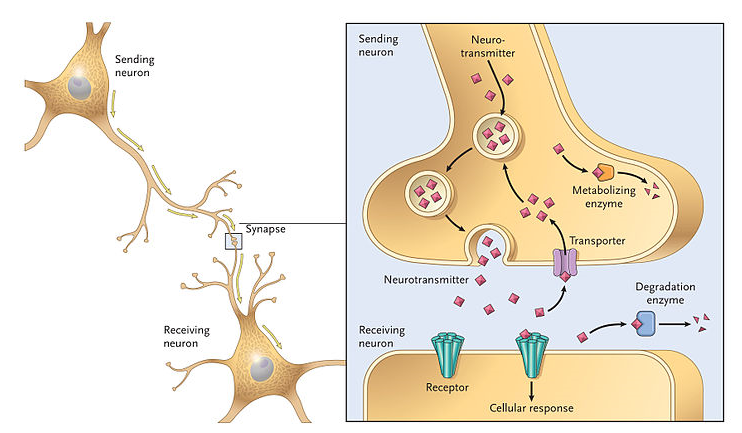
Strand B: Clinical Translational Research
Clinical Programme 2 - Early Phase Trials
Clinical Trial A: Improving brain function in Parkinson's plus by replacement noradrenergic therapy
Lead: Professor James B. Rowe
Cognitive and behavioural features are common and disabling in both PSP-Richardson’s syndrome and the ‘frontal’ PSP-F phenotype. Despite akinesia, impulsivity is common.
We have shown that noradrenaline (NA) is critical for response-inhibition and cognitive flexibility and PSP leads to early significant loss of NA-neurons in the locus coeruleus (LC). We propose that cognitive impairment in PSP is in part due to this forebrain NA depletion and that enhancing brain NA by atomoxetine restores function: analogous to serotonin re-uptake inhibitors in depression, or dopaminergic medications in Parkinson’s disease.
We have shown that atomoxetine restores brain activation, brain connectivity, and cognitive performance in advanced Parkinson’s disease. However, noradrenergic loss is more severe and occurs earlier in PSP, suggesting a greater treatment benefit.
Methods
- Ultra-high-field magnetic resonance imaging (MRI, 7 tesla)
- Cognitive testing
- Atomoxetine and placebo drug administration in PSP patients
Related publications
- Borchert, R. J., Rittman, T., Passamonti, L., Ye, Z., Sami, S., Jones, S. P., Nombela, C., Vazquez Rodriguez, P., Vatansever, D., Rae, C. L., Hughes, L. E., Robbins, T. W., & Rowe, J. B. (2016). Atomoxetine Enhances Connectivity of Prefrontal Networks in Parkinson's Disease. Neuropsychopharmacology, 41(8), 2171-2177. doi:10.1038/npp.2016.18
- Kehagia, A. A., Housden, C. R., Regenthal, R., Barker, R. A., Muller, U., Rowe, J., Sahakian, B. J., & Robbins, T. W. (2014). Targeting impulsivity in Parkinson's disease using atomoxetine. Brain, 137(Pt 7), 1986-1997. doi:10.1093/brain/awu117
- Lansdall, C. J., Coyle-Gilchrist, I. T. S., Jones, P. S., Vazquez Rodriguez, P., Wilcox, A., Wehmann, E., Dick, K. M., Robbins, T. W., & Rowe, J. B. (2017). Apathy and impulsivity in frontotemporal lobar degeneration syndromes. Brain, 140(6), 1792-1807. doi:10.1093/brain/awx101
- Lansdall, C. J., Coyle-Gilchrist, I. T. S., Jones, P. S., Vazquez Rodriguez, P., Wilcox, A., Wehmann, E., Dick, K. M., Robbins, T. W., & Rowe, J. B. (2018). White matter change with apathy and impulsivity in frontotemporal lobar degeneration syndromes. Neurology. doi:10.1212/WNL.0000000000005175
- Murley, A. G., & Rowe, J. B. (2018). Neurotransmitter deficits from frontotemporal lobar degeneration. Brain. doi:10.1093/brain/awx327
- Rae, C. L., Nombela, C., Rodriguez, P. V., Ye, Z., Hughes, L. E., Jones, P. S., Ham, T., Rittman, T., Coyle-Gilchrist, I., Regenthal, R., Sahakian, B. J., Barker, R. A., Robbins, T. W., & Rowe, J. B. (2016). Atomoxetine restores the response inhibition network in Parkinson's disease. Brain, 139(Pt 8), 2235-2248. doi:10.1093/brain/aww138
- Ye, Z., Altena, E., Nombela, C., Housden, C. R., Maxwell, H., Rittman, T., Huddleston, C., Rae, C. L., Regenthal, R., Sahakian, B. J., Barker, R. A., Robbins, T. W., & Rowe, J. B. (2015). Improving response inhibition in Parkinson's disease with atomoxetine. Biol Psychiatry, 77(8), 740-748. doi:10.1016/j.biopsych.2014.01.024
- Ye, Z., Rae, C. L., Nombela, C., Ham, T., Rittman, T., Jones, P. S., Rodriguez, P. V., Coyle-Gilchrist, I., Regenthal, R., Altena, E., Housden, C. R., Maxwell, H., Sahakian, B. J., Barker, R. A., Robbins, T. W., & Rowe, J. B. (2016). Predicting beneficial effects of atomoxetine and citalopram on response inhibition in Parkinson's disease with clinical and neuroimaging measures. Hum Brain Mapp, 37(3), 1026-1037. doi:10.1002/hbm.23087

